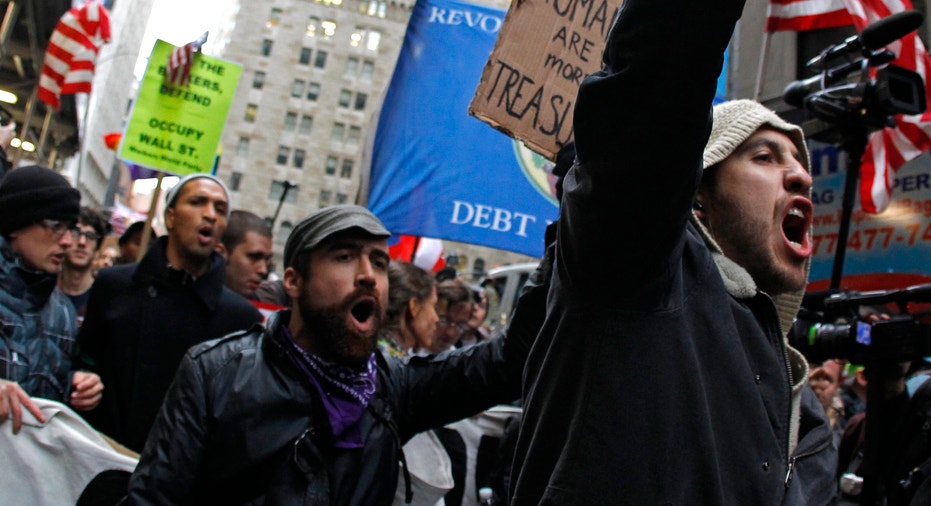Two Protest Movements, Two Divergent Paths

A year ago I wrote about the similarities between the then-brand new Occupy Wall Street protests and the slightly more mature Tea Party movement.
How things have changed in a year.
The OWS protesters gathered again in Lower Manhattan earlier this week to commemorate the first anniversary of their effort. But the protests seemed stale, a forced parody of the genuine passion displayed by many of the Occupiers a year ago. Much of the action this week appeared aimed solely at baiting cops into making arrests for the benefit of the many cameras present.
As has been their practice since forming a year ago, none of the OWS protesters came forward with a platform of specific grievances or, more importantly, a set of plausibly attainable goals.
Meanwhile, the Tea Party movement, not yet four years old, has emerged as a key voice in the growing national debate over the size, influence and -- most significantly perhaps -- the cost of government. Rising Tea Party sentiment undoubtedly played an important role in Congressman Paul Ryan's selection as Republican Presidential candidate Mitt Romney's running mate. Ryan has long been an outspoken critic of unrestrained government spending.
To recap the similarities between the two movements recall that both arose out of widespread anger over the government’s decision to bail out many of the biggest U.S. banks during the financial crisis of 2008.
The Tea Party emerged in 2009, its members deeply conservative and resentful that the government had intervened at taxpayers’ expense to rescue banks that, many Americans believe, had brought their problems on themselves.
Within a year of forming Tea Party candidates were appearing on ballot boxes across the country and the debate over the size, scope and cost of government was no longer on the margins of political conversation.
OWS Movement Has Eschewed Traditional Protest Methods
The Occupy Wall Street movement seemed to spring up out of nowhere, as hundreds of young protesters converged on Lower Manhattan on Sept. 17, 2011, eventually settling in Zuccotti Park, a block away from their perceived enemies.
From the start the Occupy Wall Streeters eschewed traditional protest methods, shunning defined leaders and specific goals. Instead, the group formed a broad umbrella under which an array of protestors gathered to make their case that the U.S. political system is rigged in favor of the rich – or the 1% as the bankers were famously branded.
“We are the 99%!” became the OWS rallying cry, and the two percentages quickly became a part of the American political and social lexicon. But beyond popularizing a couple of slogans, the OWS movement has been ineffective at pushing real reform that might tilt the scales back toward the so-called 99%.
At first, the idealism of the Occupiers seemed honorable at best, quixotic at worst. In hindsight, however, the movement’s lack of organization has proven fatal. The effort never adopted the sort of structure that would have helped it exploit the momentum it appeared to be gaining last fall.
At the time it was hard to argue that the Occupy Wall Streeters didn't raise some valid complaints. Again, many of those complaints echoed criticisms raised earlier by the Tea Partiers. After all, fat cat bankers getting bailed out by taxpayers after losing all their money in the big casino would seem to hit a universal nerve.
But this week’s protests in Zuccotti Park were emblematic of problems that plagued the movement a year ago. The protests lacked focus and too much of the energy appeared targeted for a provocative Youtube video rather than as a serious means for finding solutions to difficult and deep-rooted economic problems.
Tea Party Is Focused on the Long-Term
That’s arguably the biggest difference between the two movements. The Tea Partiers are clearly in it for the long haul while the OWS protesters take it a day (or an arrest) at time. The Tea Party has cultivated candidates nationwide and embedded themselves in the political process. Yes, they've made some mistakes -- Christine O’Donnell, the failed U.S. Senate candidate from Maryland, for instance. But the Tea Partiers seem willing to make those mistakes and move on as long as the movement stays true to its long-term principles.
Clearly those principles have broadened to a wider audience, so much so that Romney felt compelled to add Ryan to his ticket in an effort to reach out to those voters for whom scaling back government spending is a top priority.
And the notion of scaling back government, or at least making it more accountable and efficient, has reached across party lines. It’s not just conservative Republicans anymore who are demanding that taxpayer dollars be spent more responsibly.
Consider the Chicago teachers strike which ended earlier this week. A staunchly Democratic mayor, Rahm Emanuel, formerly President Obama’s chief of staff, helped trigger the strike by seeking reforms from the city’s powerful teachers union that required more accountability in the classroom.
Not too long ago, before the national debate over government spending was amped up by the Tea Party movement, a big city Democratic mayor battling a public employee union, demanding accountability in return for taxpayers funds, would have seemed an oxymoron. No longer.
A similar scenario had Occupy Wall Street gained any real traction within the political process might envision a group of Republican lawmakers pushing for stronger regulations to protect consumers against predatory banking tactics. That hasn’t happened.
The OWS message hasn’t resonated to a wider audience, one that would motivate its elected leaders to take action, and the much of the blame for that has to fall with the movement itself.